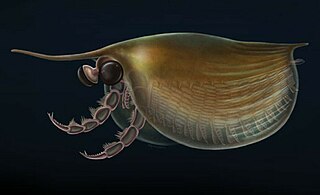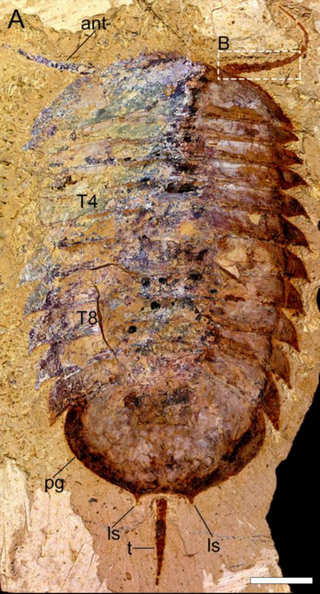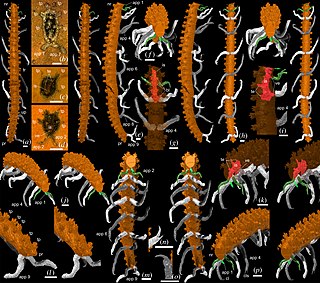
Parapeytoia is a genus of extinct arthropod that lived over 530 million years ago in the Maotianshan shales of prehistoric China. It was interpreted as an anomalocaridid (radiodont) with legs, but later studies reveal it was a megacheiran, a group of arthropods which are no longer thought to be closely related to the radiodonts.

Chasmataspidids, sometime referred to as chasmataspids, are a group of extinct chelicerate arthropods that form the order Chasmataspidida. Chasmataspidids are probably related to horseshoe crabs (Xiphosura) and/or sea scorpions (Eurypterida), with more recent studies suggest that they form a clade (Dekatriata) with Eurypterida and Arachnida. Chasmataspidids are known sporadically in the fossil record through to the mid-Devonian, with possible evidence suggesting that they were also present during the late Cambrian. Chasmataspidids are most easily recognised by having an opisthosoma divided into a wide forepart (preabdomen) and a narrow hindpart (postabdomen) each comprising 4 and 9 segments respectively. There is some debate about whether they form a natural group.

Habelia is a genus of extinct arthropod from the Middle Cambrian, thought to be one of the earliest known relatives of chelicerates. Its fossils have been found in the Burgess Shale in British Columbia, Canada. Fifty-four specimens of Habelia are known from the Greater Phyllopod bed, where they comprise 0.1% of the community.

Megacheira is an extinct class of predatory arthropods defined by their possession of spined "great appendages". Their taxonomic position is controversial, with studies either considering them stem-group euarthropods, or stem-group chelicerates. The homology of the great appendages to the cephalic appendages of other arthropods is also controversial. Uncontested members of the group were present in marine environments worldwide from the lower to middle Cambrian.

Chuandianella ovata is an extinct bivalved arthropod that lived during Cambrian Stage 3 of the Early Cambrian. It is the only species classified under the genus Chuandianella. Its fossils were recovered from the Chengjiang Biota in Yunnan, China.

Haikoucaris is a genus of megacheiran arthropod that contains the single species Haikoucaris ercaiensis. It was discovered in the Cambrian Chengjiang biota of China.

Isoxys is a genus of extinct bivalved Cambrian arthropod; the various species of which are thought to have been freely swimming predators. It had a pair of large spherical eyes, and two large frontal appendages used to grasp prey.

Occacaris oviformis is an extinct nektonic predatory arthropod from the Lower Cambrian Maotianshan shale Lagerstätte. It bears a superficial resemblance to the Cambrian arthropod, Canadaspis, though, was much smaller, and had a pair of "great appendages", with which it may have grasped prey. It was originally considered to belong to Megacheira, however it is questioned in later study.

Cucumericrus decoratus is a species of putative radiodont known from a few poorly preserved specimens. Only fragments of trunk cuticle and corresponded appendages had been revealed, while important radiodont features such as frontal appendages are unknown in this species. The trunk cuticle possess irregular wrinkles and may had been soft in life. Each of the trunk appendage compose of a dorsal flap-like element and a ventral stubby leg with unknown distal region, structurally comparable to the trunk appendages of gill lobopodians and euarthropod biramous appendages. The legs have been interpreted as somewhere between annulated lobopod legs and segmented arthropod legs.

Diania is an extinct genus of lobopodian panarthropod found in the Lower Cambrian Maotianshan shale of China, represented by a single species - D. cactiformis. Known during its investigation by the nickname "walking cactus", this organism belongs to a group known as the armoured lobopodians, and has a simple worm-like body with robust, spiny legs. Initially, the legs were thought to have a jointed exoskeleton and Diania was suggested to be evolutionarily close to early arthropods, but many later studies have rejected this interpretation.

Necrogammarus salweyi is the binomial name applied to an arthropod fossil discovered in Herefordshire, England. The fossil represents a fragmentary section of the underside and an appendage of a pterygotid eurypterid, a group of large and predatory aquatic arthropods that lived from the late Silurian to the late Devonian. The Necrogammarus fossil is Late Silurian in age and its generic name means "dead lobster", deriving from Ancient Greek νεκρός and Latin gammarus ("lobster").

Parioscorpio is an extinct genus of arthropod containing the species P. venator known from the Silurian-aged Waukesha Biota of the Brandon Bridge Formation near Waukesha, Wisconsin. This animal has gone through a confusing taxonomic history, being called an arachnid, crustacean, and an artiopodan arthropod at various points. This animal is one of the more famous fossil finds from Wisconsin, due to the media coverage it received based on its original description in 2020 as a basal scorpion.

Retifacies is an extinct arthropod that lived in the lower Cambrian. Its fossil remains have been found in the Maotianshan Shales of Yunnan, China. It is a member of the Artiopoda, and closely related to Pygmaclypeatus.

Cheloniellon is a monotypic genus of cheloniellid arthropod, known only by one species, Cheloniellon calmani, discovered from the Lower Devonian Hunsrück Slate of Germany.

Kylinxia is a genus of extinct arthropod described in 2020. It was described from six specimens discovered in Yu'anshan Formation in southern China. The specimens are assigned to one species Kylinxia zhangi. Dated to 518 million years, the fossils falls under the Cambrian period. Announcing the discovery on 4 November 2020 at a press conference, Zeng Han of the Nanjing Institute of Geology and Paleontology, said that the animal "bridges the evolutionary gap from Anomalocaris to true arthropods and forms a key ‘missing link’ in the origin of arthropods," which was "predicted by Darwin’s evolutionary theory." The same day the formal description was published in Nature.

Thanahita is a genus of extinct lobopodian and known from the middle Silurian Herefordshire Lagerstätte at the England–Wales border in UK. It is monotypic and contains one species, Thanahita distos. Discovered in 2018, it is estimated to have lived around 430 million years ago and is the only known extinct lobopodian in Europe, and the first Silurian lobopodian known worldwide.

Hallucigeniidae is a family of extinct worms belonging to the group Lobopodia that originated during the Cambrian explosion. It is based on the species Hallucigenia sparsa, the fossil of which was discovered by Charles Doolittle Walcott in 1911 from the Burgess Shale of British Columbia. The name Hallucigenia was created by Simon Conway Morris in 1977, from which the family was erected after discoveries of other hallucigeniid worms from other parts of the world. Classification of these lobopods and their retatives are still controversial, and the family consists of at least four genera.

Enalikter is an extinct arthropod described from the middle Silurian Herefordshire Lagerstätte at the England–Wales border in UK. This genus is known from only one species, E. aphson. Enalikter is described as late-living example of Megacheira, "great-appendage arthropod". It subsequently suggested to be an annelid by other researchers, however subsequent studies rejected this interpretation. Its interpretation as megacheiran arthropod has been questioned in later studies.

Bundenbachiellus is an extinct genus of arthropod described from the Lower Devonian Hunsrück Slate of Germany. This genus is known from only one species, B. giganteus. Alongside its possible relative Enalikter from Silurian, it is possible that genus is late-living example of Megacheira, "great-appendage arthropod".

Surusicaris is an extinct genus of bivalved arthropod, known from the Cambrian Burgess Shale of British Columbia, Canada. It is considered to be closely related to Isoxys, and like it has spined grasping frontal appendages.




















